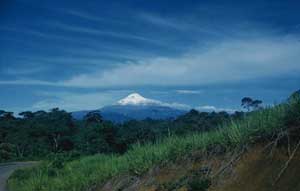|
|
 58 Volcan Orizaba, Mexico DHJanzen101191.jpg high resolution
|
|
|
Arctic-type habitats are not only found at the poles (though these high elevation glaciated areas in the tropics are also melting with the global warming - the one on Mount Kilimanjaro is noticeable smaller every year). This is Volcan Orizaba in central Mexico in the State of Veracruz on the Gulf of Mexico. At 5,700 m elevation (the third highest mountain in North America), this snow cap is permanent, expanding in the rainy season (when there is more snow) and shrinking in the dry season (when there is less precipitation). While cold and snowy, such a place differs from the Arctic (and Antarctica) in a number of key ecological ways. First, it is a small area (and getting smaller with global warming), effectively an ecological island with all that entails. Even the zone between the forest/grass and the ice/snow, which shifts it location through the seasonal cycle, is very small in area. Second, it never thaws down to ground and vegetation, not even during the two warmest months of the year (at least in the arctic, if you can tolerate the cold for most of the year, there is a somewhat warm growing season). Third, it is high elevation, with strong UV radiation from the very direct sun, cold and drying winds, and very thin air (low oxygen content). Fourth, it does not have the very long summer days and very long winter nights characteristic of the poles. Fifth, it has no energy- and nutrient-rich arctic sea next to it, spewing goodies up onto the land. And related to that, it is not beseiged by many millions of fat migrants flying in to defecate their tons of feces and cadavers to its ecosystem. Sixth, over the past millenia the glaciers have moved up and down the sides, but always just below them was a complex tropical forest blurring into lowland rainforest yet further below. Such is a very different scenario than a glaciated arctic approached by the species-poor mid-latitude communities, from which only a few species could then move into land exposed by a shrinking glacier or snow. Cold, yes, but quite inappropriately thought of as an arctic perched on a mountain. |
||
back to lecture slides
or skip to: